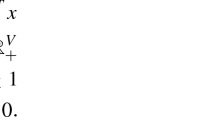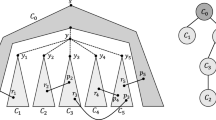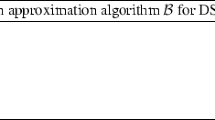Abstract
We investigate a natural online version of the well-known Maximum Directed Cut problem on DAGs. We propose a deterministic algorithm and show that it achieves a competitive ratio of \(\frac{3\sqrt{3}}{2}\approx 2.5981\). We then give a lower bound argument to show that no deterministic algorithm can achieve a ratio of \(\frac{3\sqrt{3}}{2}-\epsilon\) for any ε>0 thus showing that our algorithm is essentially optimal. Then, we extend our technique to improve upon the analysis of an old result: we show that greedily derandomizing the trivial randomized algorithm for MaxDiCut in general graphs improves the competitive ratio from 4 to 3, and also provide a tight example.
Similar content being viewed by others
References
Alon N, Spencer JH (2004) The probabilistic method. Wiley, New York
Bazgan C, Tuza Z (2008) Combinatorial 5/6-approximation of max cut in graphs of maximum degree 3. J Discrete Algorithms 6(3):510–519
Feige U, Goemans M (1995) Approximating the value of two power proof systems, with applications to MAX 2SAT and MAX DICUT. In: Proceedings of the third Israel symposium on the theory of computing and systems, pp 182–189
Goemans MX, Williamson DP (1995) Improved approximation algorithms for maximum cut and satisfiability problems using semidefinite programming. J ACM 42(6):1115–1145
Hadlock F (1975) Finding a maximum cut of a planar graph in polynomial time. SIAM J Comput 4:221
Halperin E, Zwick U (2001) Combinatorial approximation algorithms for the maximum directed cut problem. In: Proceedings of the twelfth annual ACM-SIAM symposium on discrete algorithms. Society for Industrial and Applied Mathematics, Philadelphia, pp 1–7
Karp RM (1972) Reducibility among combinatorial problems. In: Miller RE, Thatcher JW (eds) Complexity of computer computations. Plenum, New York, pp 85–103
Khot S, Kindler G, Mossel E, O’Donnell R (2004) Optimal inapproximability results for MAX-CUT and other 2-variable CSPs? In: Foundations of computer science, 2004. Proceedings. 45th annual IEEE symposium, pp 146–154
Lampis M, Kaouri G, Mitsou V (2008) On the algorithmic effectiveness of digraph decompositions and complexity measures. In: Hong S-H, Nagamochi H, Fukunaga T (eds) ISAAC. Lecture notes in computer science, vol 5369. Springer, Berlin, pp 220–231
Papadimitriou CH, Yannakakis M (1991) Optimization, approximation, and complexity classes. J Comput Syst Sci 43(3):425–440
Poljak S, Tuza Z (1995) Maximum cuts and large bipartite subgraphs. In: Combinatorial optimization. Papers from the DIMACS special year, pp 181–224
Author information
Authors and Affiliations
Corresponding author
Rights and permissions
About this article
Cite this article
Bar-Noy, A., Lampis, M. Online maximum directed cut. J Comb Optim 24, 52–64 (2012). https://doi.org/10.1007/s10878-010-9318-6
Published:
Issue Date:
DOI: https://doi.org/10.1007/s10878-010-9318-6




